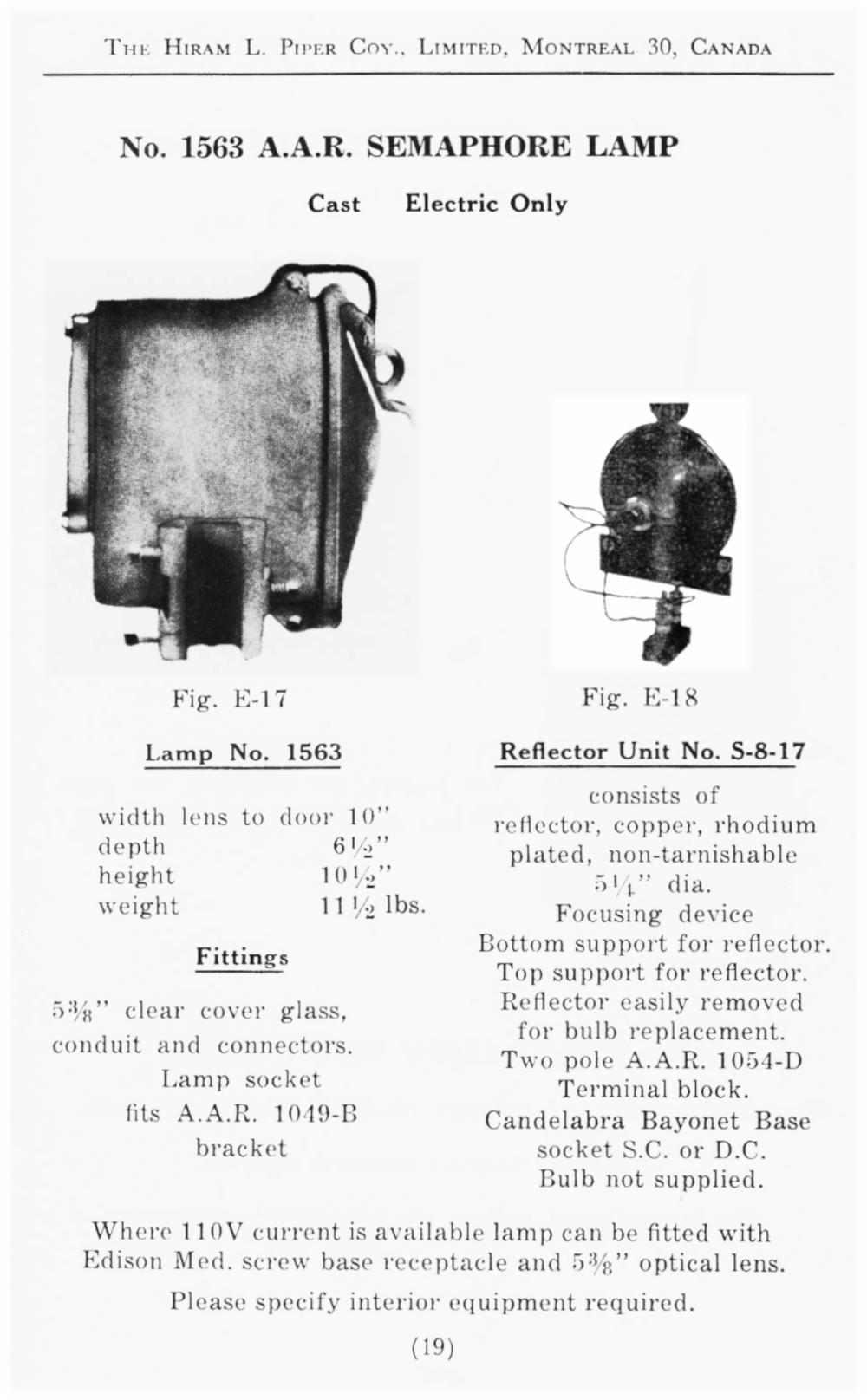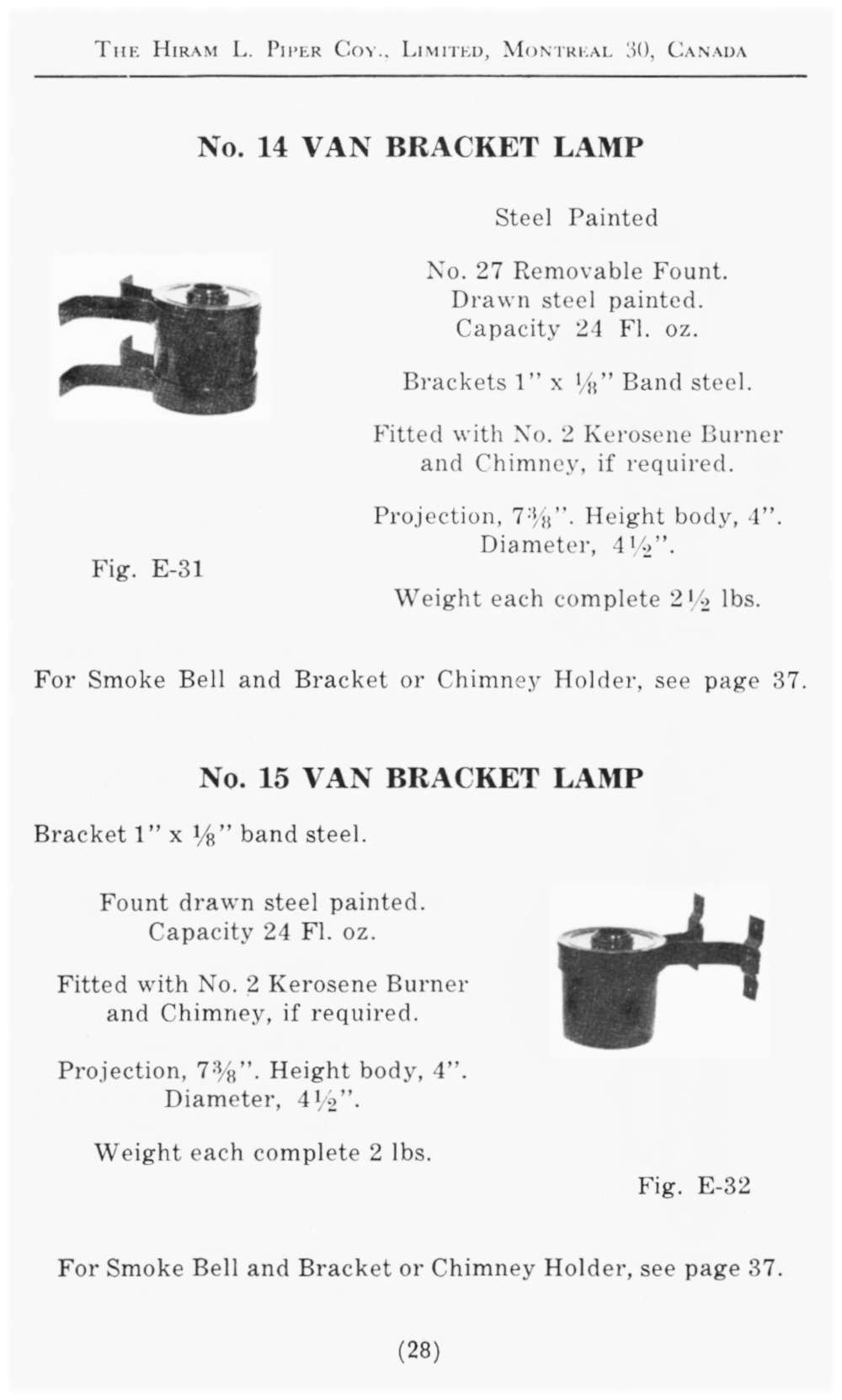This undated Piper catalogue (acquired from the company in 1962) shows railway equipment used in both the steam and diesel eras.
In this booklet one can still find many kerosene-burning items ... and oilers and 'torches' used with steam locomotives ... along with the new technologies which became popular in the post-war era.
It seems that domestic railway supply businesses (just like the locomotive builders and others) were kept alive in Canada by federal tariffs on imports of things such as 'lanterns, kerosene, trainman's, complete' ... as the regs might have identified them. One could import many parts of, for example, Adlake design and have Canadians assemble them, but importing assembled lanterns was probably prohibitively expensive.
In the catalogue, there are a few specific CNR or CPR standards for things such as markers and switchlamps. Without Piper and tariffs, perhaps American producers would have had little interest in producing these particular specialty items.
Another factor to consider is that Hiram L Piper's establishment and growth came in parallel with Canada's 'railway boom'. After this Piper scion migrated to Canada's metropolis from his family's business in Toronto, he apparently had a few years in a building near Montreal's old port (and Point St Charles), before establishing his plant in St Remi - just blocks from two other key railway facilities.
Railway Boom - Kerosene-burner Boom
Over the years, the Canadian Pacific and Grand Trunk were probably quite content with the convenience of dealing with Piper's Montreal facility. All three probably benefitted from having this long-standing relationship over a period of decades. (Perhaps there were periods where Piper had no more pricing power over the railways ... than Bangladeshi garment contractors have with today's Walmart ... but that would be hard to determine at this late date.)
Imagine all the kerosene burning train order signals located at stations across Canada which were remote from hydro-electric or coal-generated power in the 1910s and 1920s. Then add the number of switchlamps, caboose 'desk' lamps, flagging kits, markers, trainman's lanterns, class signals, etc needed all across Canada ... to comply with the rulebook requirements and to conduct kerosene-dependent operations through the night.
An earlier post looked at Piper and the urban geography of their Montreal location relative to these railways. The railway-supplier relationship was also illustrated through the proceedings of the Canadian Railway Club of Montreal. It is linked below.
Railway Equipment Suppliers - In Search of Hiram L. Piper
Subsequent to that post, a correspondent indicated there might be some interest in seeing the entire catalogue. I had always intended to make this interesting booklet available and I was provided with a welcome excuse to do it immediately.
There are no high resolution photos. The catalogue itself is an artifact.
Each page of my 'photocopying for the internet' takes a fair amount of processing, so I have divided the material into two equal parts. The second half of the catalogue will follow on a 'twenty minute block'.
... The actual printed area of each page is about 4.5 inches by 7.5 inches - including the header and page number. Often the equipment illustration has rather coarse dithering. It was necessary to find a 'blurring' filter setting which did not obscure historically important detail, while still producing a slightly less coarse image. As usual, I found that I could also bring out more detail for many items by working with the 'exposure' histograph.
Piper, using a local printing company (WH Borrie & Co, 277 Shannon Street, Montreal) for their small run of catalogues, had a very challenging task when it came to reproducing high-quality images. Photographs from other suppliers' catalogues, photographs taken in-house; drawings; probably xerography; and even engravings are found in the catalogue.
Who knows how many generations of copies have been made since the original image for each product was first created?
The catalogue printer:
 |
| from: Lovell's Montreal Alphabetical Directory, 1947. |
(Borrie, himself, lived on Beaconsfield Ave, in NDG)
... But even the most beautiful photos would not tell experienced railway purchasing personnel how much abuse a switchlamp could take over its life. The door to the interior would be pounded open and closed morning and night during its working life ... well, depending on Company edicts to save kerosene by day ... versus the availability of cheap local labour/operators to save it. The font would be pulled out for refilling one or more times during the week. Then there was servicing/replacing of the wick and regular cleaning to ensure that the lamp's fresnel lenses provided a light which could be seen at as great a distance as possible - particularly for lamps on main line switches.
So ... given all the rough daily handling a lamp would receive through all kinds of weather extremes ... setting standard specifications, and/or physically testing the product, were probably more important than catalogue images. And the railways once had their own laboratories for testing many of the items they purchased.
... and exciting lives had these lanterns! I purchased a bashed-up (and really nicely burning) CNR Piper trainman's lantern with a rough repair to its broken wire bail where its loop met the wire of the lantern. The owner had simply re-bent the 'new' end of the broken wire to re-attach it. The antique shop owner was kind of dismissive of the object ... saying that if one dragged local (formerly) trackside lakes one would find many similar artifacts.
... The shop owner probably had no interest in the fact that this item had probably travelled on steam locomotives and in wooden cabooses along lines long since abandoned. I appreciated his insight, though, as I had never imagined through which ceremonies these items might be withdrawn from service.
While I'm keeping you from doing something more important ...
 |
| from: Lovell's Montreal Alphabetical Directory, 1928. |
Above: The centre rowhouse unit, to the left of the one with the green balcony, is 94 Arlington Avenue in Westmount.
(Google July 2019 image)
The Index appears at the end of the catalogue, but it is here to provide an overview for you.
This post ends at Page 30.
* * *
Part 2 of the catalogue is here:






































